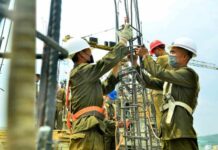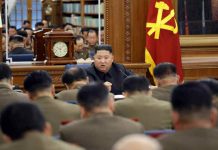[imText1]The International Atomic Energy Agency (IAEA) actual working delegation arrived in Pyongyang in the afternoon of the 26th. It has been surmised that a new stage in the implementation of the “February 13 Agreement” will begin.
Olli Heinonen, chief nuclear inspector for the IAEA joined three other IAEA delegates in Beijing and entered North Korea on the 26th. The delegation will remain in North Korea five days, until the 30th, and will meet with Lee Jae Sun, the North Korea Atomic Bureau Chief, and others to agree on the size and scope of activity of the inspection team.
North Korea, when a second round of nuclear threat erupted from the US’ development of highly-enriched uranium (HEU) in October 2002, ceased relations with the IAEA and evicted inspectors who were inspecting the Yongbyun nuclear facility in December of that year.
With the upcoming delegation’s visit to North Korea, IAEA Director-General Mohamed ElBaradei began the first round of negotiations by visiting North Korea in March. Further, around the time of the US-North Korea Geneva Conference, an IAEA inspector had experience freezing a North Korean nuclear facility, so this agreement should not face huge problems.
The nuclear facility to be discussed with the North includes the Yongbyun 5MW nuclear reactor, which was the target of freeze around the 1994 Geneva Convention, the radiation chemistry experimental lab (nuclear reprocessing facility), nuclear fuel rod production facility, Yongbyun 50MW nuclear reactor which is currently being constructed, the Taechun 200MW nuclear reactor, and others. However, it is possible that the Taechun 200MW nuclear reactor, for which a building ground was being constructed, will be excluded.
Related to this, Japan’s Mainichi Shimbun reported on the 25th that the nuclear facilities which North Korea will freeze first are the 5MW nuclear reactor and the radioactive chemistry experimental lab. The Mainichi Shimbun relayed that the related nations of the six party talks have expressed their preference in prioritizing these two places.
However, it is feasible that the IAEA will propose additional targets of abolition, besides the Yongbyun nuclear facility. There are of course plutonium and nuclear materials which have already been produced, as well as the isotope production research lab, which has already been identified by our government’s army, and three other waste facilities which have not been reported to the IAEA. Thus, a psychological warfare between the two sides regarding the scope of abandonment.
After the IAEA delegation completes its five-day activity, it will introduce a resolution of agreement upon deliberating with the North around the 30th of this month, and around the beginning of next month, through a decision of an IAEA special committee, an IAEA inspection team will visit the North and will unfold inspection projects, regulation during sealing, and abandonment of nuclear facilities until the middle of next month.
Abolition and sealing projects, after ceasing operation of nuclear reactors, will pull out fuel rods by cooling nuclear fuels, and are actualized by covering nuclear facilities or putting a lock, so that they cannot reoperate. A government official at the Ministry of Foreign Affairs in South Korea predicted that equipment and facilities are around 700-800 and around 20 cameras will be installed to observe whether or not North Korea will cause damage in ordinary times.
Simultaneously, Heinonen, an expert who has a background in radiation chemistry, was born in Finland and joined the IAEA in 1983 and stepped foot in Pyongyang for the first time as a member of the North Korean nuclear inspection team in ’92. Subsequently, anytime North Korea’s nuclear threat reached a climax in 1994 and in 2002, for instance, he has actively been involved in inspecting the Yongbyun nuclear facility, so has drawn interest around his activity.
Especially, around the first-round of North Korea’s nuclear threat in 1992, he is a main character who captured the decisive evidence that North Korea’s plutonium extraction amount significantly exceeded what had been reported. North Korea reported that it extracted 90g of plutonium once in 1990, but the IAEA inspection team demanded additional inspection by confirming evidence that North Korea extracted over 1kg of plutonium over three time periods–in ’89, ’90 and in ’91.




















